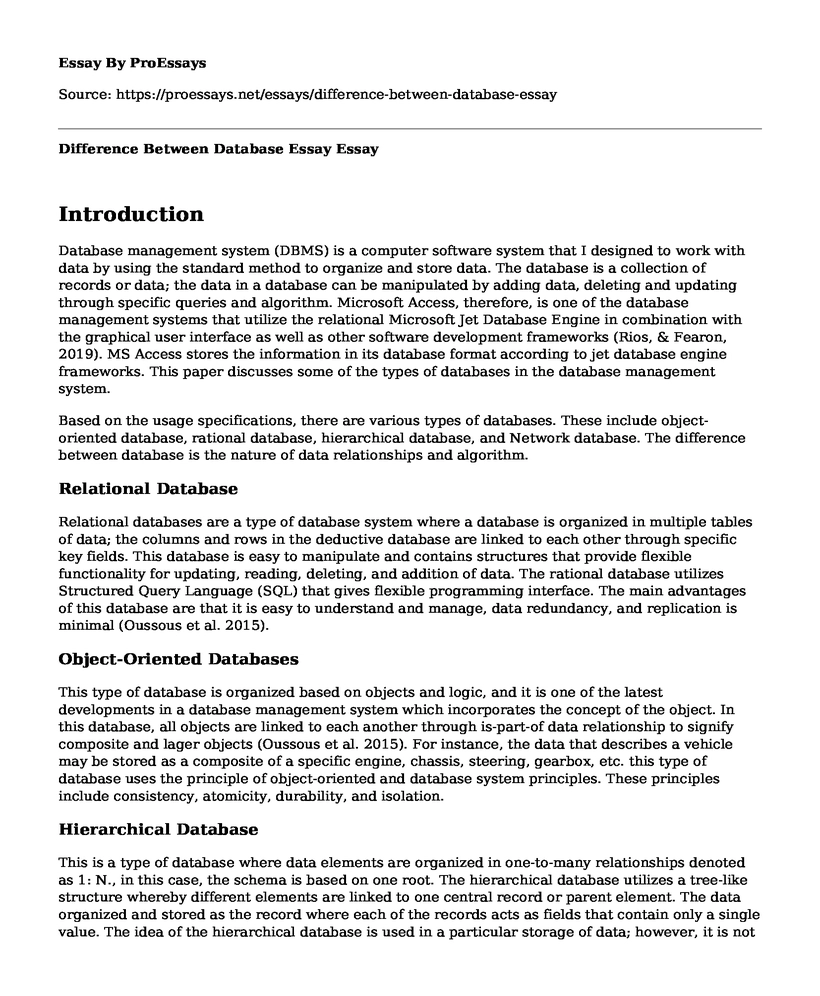Introduction
Database management system (DBMS) is a computer software system that I designed to work with data by using the standard method to organize and store data. The database is a collection of records or data; the data in a database can be manipulated by adding data, deleting and updating through specific queries and algorithm. Microsoft Access, therefore, is one of the database management systems that utilize the relational Microsoft Jet Database Engine in combination with the graphical user interface as well as other software development frameworks (Rios, & Fearon, 2019). MS Access stores the information in its database format according to jet database engine frameworks. This paper discusses some of the types of databases in the database management system.
Based on the usage specifications, there are various types of databases. These include object-oriented database, rational database, hierarchical database, and Network database. The difference between database is the nature of data relationships and algorithm.
Relational Database
Relational databases are a type of database system where a database is organized in multiple tables of data; the columns and rows in the deductive database are linked to each other through specific key fields. This database is easy to manipulate and contains structures that provide flexible functionality for updating, reading, deleting, and addition of data. The rational database utilizes Structured Query Language (SQL) that gives flexible programming interface. The main advantages of this database are that it is easy to understand and manage, data redundancy, and replication is minimal (Oussous et al. 2015).
Object-Oriented Databases
This type of database is organized based on objects and logic, and it is one of the latest developments in a database management system which incorporates the concept of the object. In this database, all objects are linked to each another through is-part-of data relationship to signify composite and lager objects (Oussous et al. 2015). For instance, the data that describes a vehicle may be stored as a composite of a specific engine, chassis, steering, gearbox, etc. this type of database uses the principle of object-oriented and database system principles. These principles include consistency, atomicity, durability, and isolation.
Hierarchical Database
This is a type of database where data elements are organized in one-to-many relationships denoted as 1: N., in this case, the schema is based on one root. The hierarchical database utilizes a tree-like structure whereby different elements are linked to one central record or parent element. The data organized and stored as the record where each of the records acts as fields that contain only a single value. The idea of the hierarchical database is used in a particular storage of data; however, it is not very versatile. Its functionally is to a particular use. For example, a case where a person in an organization reports to a specific department, therefore, the department may categorize as parent record and individual workers to represent secondary records whereby each record links back to a particular record in the structure.
Network Database
This database is based on a network structure in creating a relationship of different entities. It is mainly utilized in handling extensive digital data. A network database is hierarchical in the structure; however, unlike the hierarchical database where a single node relates to one record, in this database, one node can be related to multiple entities. This database provides a link between multiple parents as well as many child records. This database is based on many-to-many relationships and forms an interconnected network-like structure (Elmasri, & Navathe, 2017).
In comparison, Object-oriented database is a type of database that relies on objects that consist of stored values that unites development of database and the application, whereas the relational database is based on relations. In the object-oriented database, the elements relate to a given object based on the object-oriented paradigm (Tang et al. 2016). Also, the relational database organizes and stores data in tables that consist of rows and columns, whereas object-oriented database data is stored based on the objects along with actions that help in reading or processing the data.Conclusion
In summary, all databases, various types of databases have been developed to satisfy the requirements of data storage, retrieval, and processing. All of the database models have a unique approach to data organization based on various principles. An object-oriented database is the most recent development in database management systems. The database provides a secure platform for linking various independent data files that may contain related or overlapping data using different frameworks and principles to achieve different objectives.
References
Elmasri, R., & Navathe, S. (2017). Fundamentals of database systems. Pearson.
Oussous, A., Benjelloun, F. Z., Lahcen, A. A., & Belfkih, S. (2015, May). Comparison and classification of nosql databases for big data. In Proceedings of International Conference on Big Data, Cloud and Applications (Vol. 2).
Rios, F., & Fearon, D. (2019). Microsoft Access Data Curation Primer.
Tang, J. K., Pierce, E. C., Prestwood, G. R., McMillon, T., & Swanson, T. E. (2016). U.S. Patent No. 9,384,202. Washington, DC: U.S. Patent and Trademark Office.
Cite this page
Difference Between Database Essay. (2022, Mar 11). Retrieved from https://proessays.net/essays/difference-between-database-essay
If you are the original author of this essay and no longer wish to have it published on the ProEssays website, please click below to request its removal:
- Essay Sample on Backup Procedures
- Essay Example on Build a Gaming PC: A Guide to Components, Software & Peripherals
- Small Multiples: Unlocking the Power of Data Vis. With Edward Tufte - Essay Sample
- Essay Example on Regulating Cyberspace: Borderless Internet, Regulatory Power and Self-Regulation
- Essay Sample on Gamification: Enhancing Learning with Fun and Excitement
- Essay Sample on Ultrasound: A Nurse's Tool to Identify Pressure Injuries
- Free Essay Sample on Cloud Distributed Databases







